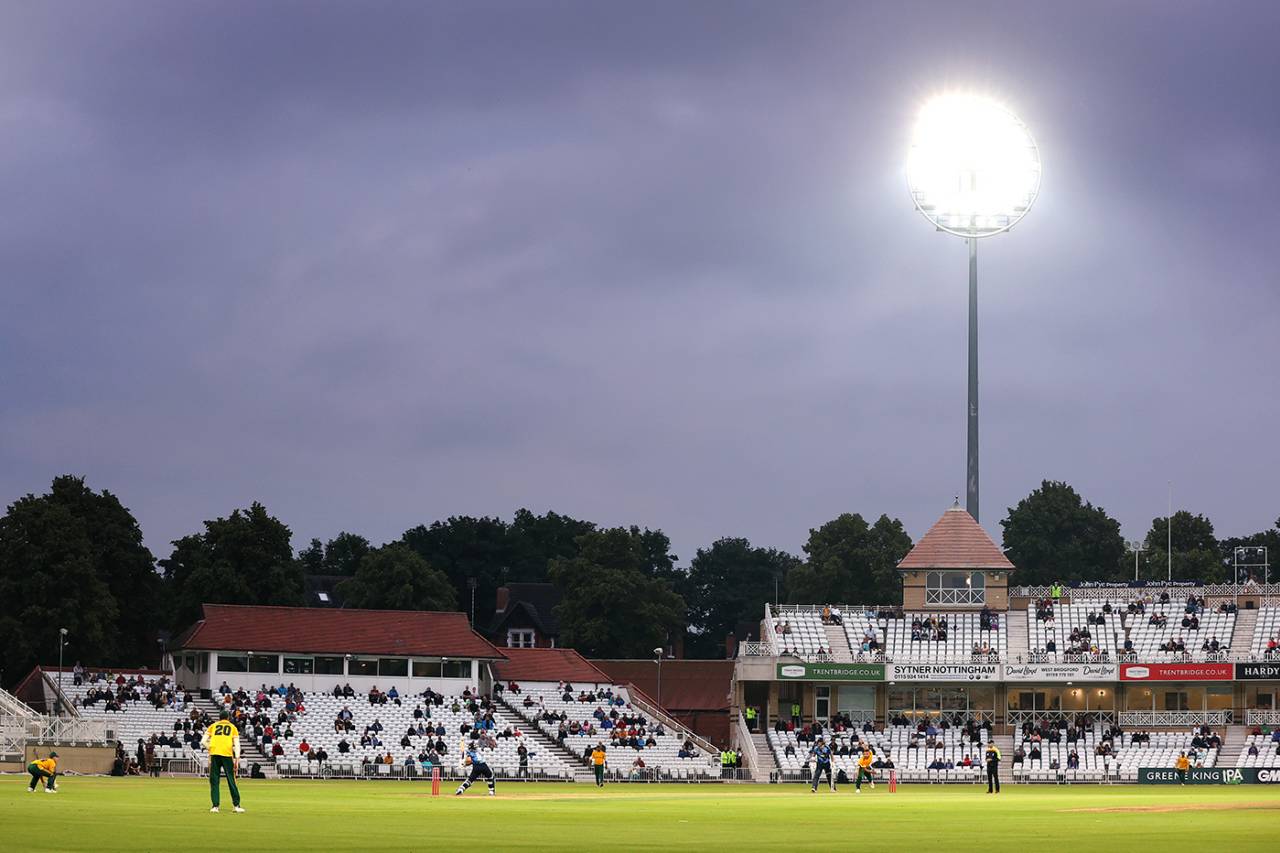Why recruiting to maximise home advantage is the next stage of T20 development
Shouting at the umpires can only do so much but ground dimensions are firmly on analysts' radars
Cameron Ponsonby
23-Aug-2021

Nottinghamshire have only lost one T20 fixture at home in the last two seasons • Getty Images
Over the last ten years of the Blast (or its predecessor, the FLt20), of the 40 quarter-finals played, exactly 20 have been won by the home side and 20 by the away.
That feels weird. Surely, even in a format as short and volatile as T20, there must be some form of advantage to playing at home? Otherwise, what's all the fuss about in securing a home quarter?
In 2005, the international bestseller Freakonomics narrowed down home advantage essentially to how close your fans are to the referee; if they yell at him or her enough, human nature will kick in and they will give you more close decisions than they won't. Basically, peer pressure and bullying works. Which is nice.
But that study related mainly to sports such as American football, soccer, ice hockey, basketball, etc. Sports where playing dimensions and surfaces are standardised and not, as is the case in cricket, sports where pitches can be doctored or where outfields can vary greatly in size and shape.
For instance, at Nottinghamshire's Trent Bridge, the new stand that runs parallel to Bridgford Road cuts across the outfield in a way that means the playing area resembles a circle that someone has snipped an edge off. It creates a very short part of the boundary that, combined with an excellent batting surface, leads to high scoring contests.
On Wednesday, Nottinghamshire will host Hampshire in the second quarter-final. They have lost just one game of T20 cricket at home over the last two years.
"We know the dimensions of our ground", Nottinghamshire captain, Steven Mullaney, says, "and we know how we want to play cricket at Trent Bridge."
"Batters come here and they fancy it [the short boundary], but at the same time their bowlers come here and they're not used to defending it. So I think that is an advantage."
It's a sentiment that Lancashire's spin consultant Carl Crowe agrees with.
"It's about adapting," Crowe says, ahead of his side's away quarter-final at Somerset. "That's as a team and as an individual. The best teams and the teams that win the tournament are the best at that. Yes, you've got half your games at home but you've also got half your games away that are just as important."
Both Mullaney and Crowe express a notion that, rather than home advantage being anything explicitly tangible, it's just something that lingers over a game. You'd rather play at home because of course you would. You sleep in your own bed, you're comfortable on arrival, it's your fans not theirs, the club gets the gate receipts, you know the woman at the gate and you know the bloke at the bar. It's, well, home.
And currently in the Blast, home advantage doesn't always seem to exist at all. This season was the first group stage since 2017 to see more home wins than away. However, whilst at first appearing like a standout statistic, it doesn't quite account for the fact that in general good teams are good (so win home and away), and bad teams are bad (so lose home and away). But, it paints a picture similar to a sentiment expressed by Mullaney.
"I don't think [advantage] is the right word", he says, "Obviously it is a home advantage but I don't think it's an advantage as in - it's not a manipulative advantage - it's just that you know what to do at your ground."
But, shouldn't it be a manipulated advantage? It's your house after all, so why not play to your rules?
Recruitment in particular seems to be an open goal where teams could maximise their chances at home. If you play at a small ground, recruit high end boundary hitters. Big outfields? Need people who can run two. Spin-friendly pitches? Need batters who can play against spin.
So how much do teams tend to factor in ground dimensions and quirks to their recruitment?
"At the moment, not a lot," Somerset analyst Scott Thomas says. "But that's definitely my biggest plan for the next three-to-four years."
"I just did my Masters dissertation on that kind of stuff using player impact ratings in T20 cricket. I compared and contrasted how valuable overseas players are. How do they impact games of cricket in a positive way and not being worried about stuff like averages or old school traditional measures, but how do they win you games of cricket full-stop.
"That's my winter's work because the summer is just so busy. Even if that's trying to change some opinion in the club about how recruitment could be done a bit better, because I think cricket is so far behind in that sense."
There are obvious difficulties facing counties in this regard that aren't faced by, say, a franchise side, whether that be in the Hundred or the IPL. Counties aren't exclusively T20 teams and players are often developed as opposed to recruited. But, it is on the radar of analysts, meaning it will be on the radar of the game as a whole before long. And who knows, in five years' time the statistics next to the home wins column may look very different.
In the meantime, if you're a home fan at one of this week's quarter-finals, just yell at the ump from a 100 yards away. Worth a go.
Cameron Ponsonby is a freelance cricket writer in London. @cameronponsonby
